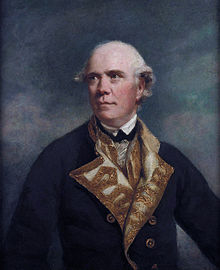Samuel Barrington
Samuel Barrington | |
|---|---|
 Rear-Admiral Barrington | |
| Born | 1729 |
| Died | 1800 |
| Allegiance | |
| Service | |
| Years of service | 1740–90 |
| Rank | Rear admiral |
| Relations | John Shute Barrington, 1st Viscount Barrington (father) |
Admiral Samuel Barrington (1729–1800) was a British admiral.
Samuel was the fourth son of John Shute Barrington, 1st Viscount Barrington of Beckett Hall at Shrivenham in Berkshire (now Oxfordshire). He entered the Royal Navy at the age of 11, and by 1747 had been promoted to post captain.
Seven Years War
He was in continuous service during the peace of 1748–56, and on the outbreak of the Seven Years' War served with Admiral Edward Hawke in the Basque Roads in command of HMS Achilles.
In 1759 Achilles captured a powerful French privateer, after two hours’ fighting. In the Havre-de-Grace expedition of the same year Barrington's ship carried the flag of Rear-Admiral George Brydges Rodney, and in 1760 sailed with John Byron to destroy the Louisbourg fortifications. At the peace in 1763 Barrington had been almost continuously afloat for twenty-two years.
He was next appointed in 1768 to the frigate HMS Venus as governor to the Duke of Cumberland, who remained with him in all ranks from midshipman to rear admiral.

Between 1772 and 1775 He accompanied Captain John Jervis to Russia where they spent time in St. Petersburg and inspected the arsenal and dockyards at Kronstadt and took a tour of the yacht designed by Sir Charles Knowles for Catherine the Great. The pair continued on to Sweden, Denmark and northern Germany. All the while Jervis and Barrington made notes on defences, harbour charts and safe anchorages. They came home via the Netherlands, the two once again making extensive studies of the area and took copious notes describing any useful information.
Barrington and Jervis then took a private cruise along the Channel coast calling at various harbours including Brest and making and improving their charts as they went. Barrington and Jervis, later Earl St. Vincent remained firm friends throughout their lives. On his return home, Barrington was offered, but declined, the command of the Channel fleet.
Barrington's last active service was the relief of Gibraltar in October 1782. As admiral he flew his flag for a short time in 1790, but did not serve in the French Revolutionary Wars. He died in 1800.
Santa Fe Island, also called Barrington Island, in the Galapagos was named after him.
References
- Chisholm, Hugh, ed. (1911). . Encyclopædia Britannica (11th ed.). Cambridge University Press. which in turn cites:
- Ralfe, Naval Biographies, i. 120.
- Charnock, Biographia Navalis, vi. 10.
